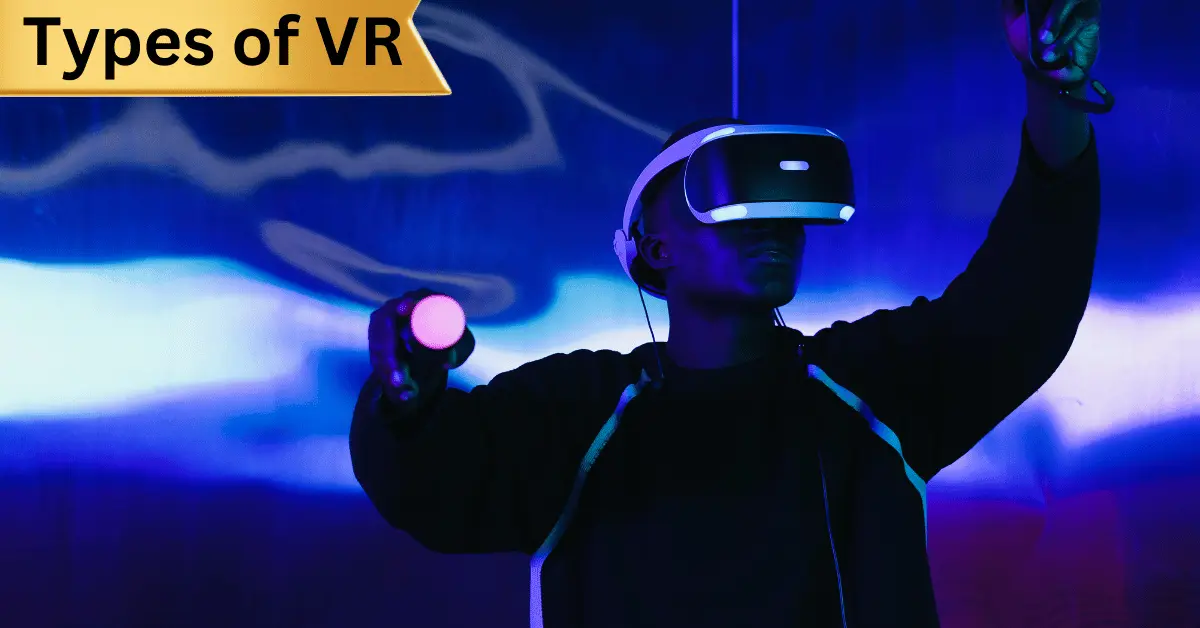6 Types Of Virtual Reality | Perfect VR Information [2025]
Published: 5 Apr 2025

Virtual reality is transforming the way we interact with the digital world. From gaming to education, its different non-immersive, semi-immersive, fully immersive, augmented, and collaborative VR offers unique experiences for learning, working, and playing.
1. Non-Immersive Virtual Reality
Imagine you’re playing a video game. You control a character on the screen—making it move, jump, or explore. But you’re not inside the game; you’re like the director, sitting in the real world and controlling everything from a distance. That’s what we call non-immersive virtual reality!
How Does It Work?
Non-immersive VR uses devices like computers, gaming consoles, keyboards, and controllers to let you interact with a virtual world. For example:
- You press a button, and your character runs.
- Move a joystick, and your character turns.
It’s like a remote control for a pretend world.
Why is It Cool?
- For Gamers: Systems like Xbox, PlayStation, and even computer games let you experience this kind of VR.
- For Learning: Did you know that soldiers in the US Army train their planning skills by playing strategy games? They’ve been using these games since 2018 to learn how to think ahead!
- For Fun Meetings: In one video game, called World of Warcraft, scientists even held meetings inside the game world. They used it like a fun, creative meeting room!
What Makes It Different?
In non-immersive VR, you’re not “in” the game. The game’s focus is on the characters you control, not you. It’s like being a puppet master controlling a digital puppet—but from your chair!
2. Fully Immersive Virtual Reality
Fully immersive virtual reality lets you step into a pretend world that feels completely real! You’ll feel like you’re actually there, and everything that happens seems like it’s happening to you for real.
How Does It Work?
To use this type of virtual reality, you need special gear, like helmets, gloves, and body connectors. These gadgets have sensors that can detect your movements, reactions, and even tiny things like blinking your eyes! They connect to a powerful computer that turns your actions into what happens in the virtual world. It feels like you’re inside the game or virtual space.
A Cool Example:
Imagine playing in a Virtual Shooter game. You’d wear the gear and stand in a small room. Through the helmet, you’d see a pretend world where you’re facing opponents trying to defeat you. To play, you’d move your body and arms to do things like run, jump, crouch, shoot, and throw—all inside the game.
What Else Can Fully Immersive VR Do?
- Medical Training: Doctors are exploring the idea of using VR to train brain surgeons. This way, they can practice safely and avoid mistakes during tricky surgeries.
- Learning in Schools: VR is also being used to make lessons exciting and interactive. It’s helping students learn in new, fun ways.
Why Isn’t It Everywhere?
Fully immersive virtual reality is very expensive, and not many people can afford it yet. Scientists and creators are still working on making it better and more available for everyone.
3. Semi-Immersive Virtual Reality
Semi-immersive virtual reality combines parts of both non-immersive and fully immersive VR. It lets you explore a pretend 3D world using a computer, phone, or a VR headset. In this type of VR, everything in the virtual world focuses on you, but your movements in the real world are limited. You only experience things visually, without physically walking or jumping around.
How Do You Explore the Virtual World?
- On a computer: You can use a mouse to move through the virtual space.
- On a phone: You can touch and swipe, or in some cases, you’ll need to move the phone itself to look around.
With a VR headset, the experience becomes more lifelike. When you wear the headset, you can only see the virtual world—it feels like you’re really there!
What Makes It Special?
Many semi-immersive systems use something called a gyroscope. This means the virtual environment adjusts based on the way you tilt or move your phone or VR device. For example:
- Moving your phone up, down, or sideways changes what part of the virtual world you see.
- With a VR headset, you just turn your head to explore, without using your hands.
This creates a more realistic and exciting experience!
Where is Semi-Immersive VR Used?
- Education: Teachers use semi-immersive VR to make learning fun. Students can explore historical events, visit faraway planets, or even dive into the ocean—all without leaving the classroom.
- Virtual Tours: Many businesses, like hotels, schools, or real estate companies, use VR tours to show off their spaces. People can explore these places online from anywhere!
- Training: Semi-immersive VR is also used to train people in different fields, like pilots or doctors, by simulating real situations.
Why is it Popular?
Semi-immersive VR is cost-effective, meaning it’s not too expensive to create or use. That’s why it’s one of the most widely used types of VR after non-immersive VR. It’s a great mix of technology and accessibility, making it perfect for fun, learning, and business!
4. Augmented Reality
Augmented reality, or AR, is like magic that lets you see something on your screen that isn’t really there in real life. Instead of taking you to a pretend world, AR brings a pretend thing into the real world using a device like your phone or tablet.
How Does It Work?
Imagine you’re looking at your room through your phone. Now, let’s say you place a cartoon character in the corner of the room. When you look through your phone, you can see the character standing there, but if you put the phone down, it’s gone! That’s augmented reality.
Why is Augmented Reality Useful?
AR isn’t just for fun; it’s super helpful too!
- For Shopping: Imagine you want to buy a table. With AR, you can place the virtual table in your room using your phone. This helps you see if the table fits and looks good before buying it.
- For Businesses: Companies like furniture stores and decorators use AR to show how their products will look in your space.
Is AR Part of VR?
Some people say AR is a different kind of technology because it doesn’t fully take you into a pretend world like virtual reality does. But since it adds virtual things to the real world, it’s sometimes grouped with VR.
5. Collaborative Virtual Reality
Collaborative VR is a virtual world where people from different places can meet and interact with each other. These people appear in the virtual space as 3D or animated characters they can control. It’s like meeting friends in an online game but in a more advanced and interactive way.
How Does Collaborative VR Work?
Imagine playing a game like PUBG, where players from all over the world join as characters they can control. Similarly, in collaborative VR:
- People use devices like microphones, headsets, and computers to talk and interact.
- They can move their characters, explore the virtual world, and even chat, just as if they were together in real life.
Where is Collaborative VR Used?
- Gaming: Game development platforms like Unity use this idea to create fun and social games. Adding easy-to-play features, called “hybrid casual elements,” makes these games even more exciting.
- Work and Meetings: Collaborative VR is becoming popular for remote business meetings and even debate competitions! Virtual meeting rooms allow people to connect and work together as if they’re in the same room.
- Innovation in Industries: Just like online gaming changed its world, collaborative VR is bringing fresh, creative experiences to other areas like education, work, and entertainment.
6. Mixed Reality
Mixed reality, or MR, is like a blend of real life and digital worlds. It combines elements of both augmented reality (AR) and virtual reality (VR), allowing real and virtual objects to interact in one space.
How Does It Work?
Mixed reality uses special devices like smart glasses or headsets. These devices let you see the real world around you while also adding digital objects that you can interact with. For example, you could place a virtual chair in your room and sit on it as though it’s actually there!
Cool Examples of Mixed Reality
- Learning: Students can study biology by seeing a 3D hologram of the human body that they can touch and explore.
- Gaming: MR lets you fight virtual monsters in your real living room or interact with characters as if they’re right in front of you.
- Work: Engineers and architects use MR to design buildings, allowing them to view a 3D model in the real construction space.
Why is Mixed Reality Important?
MR isn’t just for fun. It’s a powerful tool for solving real-world problems, like teaching, training, and planning. It creates a seamless connection between our real environment and technology.
What Makes Mixed Reality Different?
Unlike augmented reality, MR objects are more realistic and can interact with the real world. And unlike virtual reality, MR doesn’t take you fully into a pretend world; it connects both worlds.
Conclusion
Virtual reality bridges imagination and reality, opening doors to innovation and creativity. As technology advances, VR continues to reshape industries, bringing new opportunities to connect, collaborate, and explore.
Because you interact with the virtual world through a screen without feeling like you’re inside it.
Yes, it can also be experienced on computers, mobile devices, and using basic input tools like keyboards or mice.
Unlike fully immersive VR, you’re controlling the game or environment from a distance, not becoming part of the world.
Gaming consoles like PlayStation and Xbox, as well as PCs and laptops, provide great non-immersive VR experiences.
Absolutely! Teachers can use non-immersive VR to introduce interactive lessons, such as simulations or virtual labs.
It may stem from unfamiliarity with input devices or software settings, which can often be adjusted for ease.
Yes, many games and platforms support multiplayer modes, allowing users to play and collaborate online.
It offers strategic simulations that improve planning, such as those used by the US Army.
Yes, virtual platforms like World of Warcraft have creatively hosted conferences and meetings for professionals.
Yes, since it doesn’t require expensive equipment like helmets or sensors, making it accessible to more users.

- Be Respectful
- Stay Relevant
- Stay Positive
- True Feedback
- Encourage Discussion
- Avoid Spamming
- No Fake News
- Don't Copy-Paste
- No Personal Attacks

- Be Respectful
- Stay Relevant
- Stay Positive
- True Feedback
- Encourage Discussion
- Avoid Spamming
- No Fake News
- Don't Copy-Paste
- No Personal Attacks

![Is VR Worth It? | Get a Perfect Solution [2025] - Post Thumbnail](https://techpuk.com/wp-content/uploads/is-vr-worth-it-100x52.webp)



